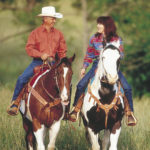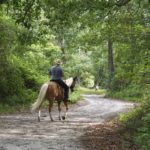There was a time when equestrians did not need to be concerned about development as a threat to our hobby, sport and industry; but that time has long since passed. As the U.S. population has grown and communities have expanded, most regions of the country are experiencing the “sprawl” that consumes our horse lands?-spaces for growing hay, raising and training horses, competition sites, boarding stables, youth riding camps and academies, trails and recreational riding spaces. In fact, in many communities, the rate of sprawl often exceeds the rate of population growth. Horse land protection depends upon our active engagement in land use planning in our communities.

What is Land Use Planning?
Land use planning is an important activity that assists a community grow and function in the manner that is needed and desired by its residents. As the population in a community changes, there is a need to plan for future land uses. The outcome of these plans is typically articulated through a series of planning guidelines and zoning regulations. In some of the most rural communities, planning and zoning does not exist. When growth occurs in a rural community, there is generally a period of unregulated building and community development that is followed by the community members resisting the random growth patterns and pressing for more organized growth through planning and zoning.
Critical elements of land use planning are the slopes and soils in the region. Lands with well drained, nutrient and mineral rich soils are ideal for agricultural activity. These types of soils support a strong agricultural economy. The slope of the land is important as well. It is easier to produce most agricultural crops on level fields Additionally, if you build on the best soils, you then displace agricultural to less productive soils and reduce the agricultural economy and quality in your community.
A community comprehensive plan is commonly used to develop a guide for future growth and development. The plan is developed through a series of information gathering, public input and drafting processes conducted by a community planning employee with the assistance of a committee of community volunteers. It is also common for a community to hire an independent planning consultant to assist with the process. After the most current data is gathered, the first draft of the plan is assembled (or edited from prior versions) by the planning committee and then presented to the public for their review and comment. After the comment period, the draft plan is then edited to more accurately reflect the desires of the community members. The goal is for the final plan to represent the wishes of the residents in the planning area. The plan often takes into account the preservation of natural features, protection of the water supply, historic elements, transportation needs, locations for residential, commercial, agricultural, public service facilities (schools, hospitals, government buildings) and industrial development.
In some states, such as Maryland, law requires comprehensive land use planning at the county-level. In other states, some communities practice land use planning although law does not require it. A comprehensive plan may provide justification for community zoning laws.
The planning process asks the following questions:
- ?Where are we now with regard to the use of our land?
- ?What do we value?
- ?What do we need?
- ?How do we get there?
The planning process includes a period of data gathering, drafting and resident comment on the following:
- ?Population trends
- ?Current use of planning area lands (urban and rural)
- ?Transportation systems & commuting patterns
- ?Communications infrastructure
- ?Community facilities (educational, emergency services, health care)
- ?Parks, greenways and recreation opportunities
- ?Buildings (housing, agriculture and commercial development)
- ?Watershed protection
The completed comprehensive plan typically includes a vision statement, planning goals and guidelines, maps, recommended zoning policies and community regulations, and an implementation strategy. Typically, comprehensive plans are county-based and updated every five to six years. In larger and more densely populated areas, county-wide plans may be broken down into area plans. Most communities post their comprehensive plan or some portion of it on their county planning department web site. If you do not find it there, request a hard copy from the county planner. Identify your planning staff and members of the planning committee. Be alert for notice of the plan revision, seeking of candidates for appointment to the volunteer planning committee, and public comment periods.
Why Is It Important for Equestrians to Participate?
Resident equestrians can make a significant, positive difference in the plan outcome through their participation in the planning process. The ideal situation is when equestrians are involved at all levels of the planning process, including having a community employed planning professional who is a horseman or at least understands the equestrian community, its financial impact and benefits for the community. If that is not the current situation, horsemen are encouraged to get to know their land use planner and inform them about the equine activities and economy in the community. Take the planner on a farm tour; introduce them to a veterinarian, a farrier, a hay producer and others who are a part of the equine economy to help them understand the employment and economic community?s plans. These might be, for instance, a community wide equine accessible trail and greenway system linking parks, public forests, conservation and public lands. Is there a county or state-wide program to encourage the development of trails and greenways to connect public lands using private lands with landowner agreements and liability protections? Does your community have an equestrian friendly park with a boarding stable and lesson program? Is there a public cross-country course available? Are their arenas for training and public facilities to hold horse shows, and youth equine programs and events?
As the cost of horse keeping increases, we are all more aware of the need to have local producers of hay and grain. Protecting agricultural locations for the production of hay and grain is important.
The U.S. Census is currently engaged in counting all US residents to determine population, density and community needs. The final count will impact population growth trends, the need for new or expanded community services, housing and commercial development. The final results will impact your community and its plans for the future. It is essential that all horsemen are aware of and participate in their community planning in order to protect our horses and community of equestrians.
Most importantly, every horseman can participate in land use planning. You do not need to own land nor a horse, but your voice can make a difference in preserving land for horse-related activity in your community.
For more information on this topic and ELCR, visit www.elcr.org or call the Equine Land Conservation Resource at (859) 455-8383.





